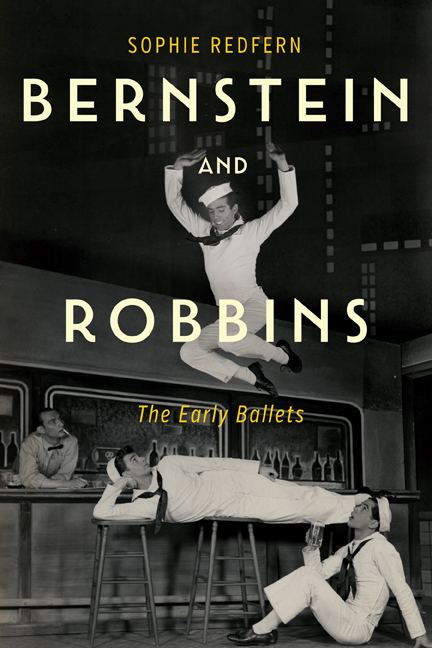Book contents
- Frontmatter
- Dedication
- Contents
- List of Illustrations
- Acknowledgments
- List of Abbreviations
- Editorial Note
- Preface
- 1 Setting the Scene: American Ballet and Jerome Robbins
- 2 Toward a First Ballet: Fancy Free Takes Shape
- 3 Creating Fancy Free: A Long-Distance Collaboration
- 4 The Music of Fancy Free: The Sketches and Score Explored
- 5 The Fancy Free Premiere and a Move to Broadway
- 6 Toward a Second Ballet: Bye Bye Jackie and the Creation of Facsimile
- 7 The Music of Facsimile: The Sketches and Score Explored
- 8 The Facsimile Premiere and Legacy of the Ballets
- Epilogue: Bernstein and Dance
- Bibliography
- Index
6 - Toward a Second Ballet: Bye Bye Jackie and the Creation of Facsimile
Published online by Cambridge University Press: 23 March 2021
- Frontmatter
- Dedication
- Contents
- List of Illustrations
- Acknowledgments
- List of Abbreviations
- Editorial Note
- Preface
- 1 Setting the Scene: American Ballet and Jerome Robbins
- 2 Toward a First Ballet: Fancy Free Takes Shape
- 3 Creating Fancy Free: A Long-Distance Collaboration
- 4 The Music of Fancy Free: The Sketches and Score Explored
- 5 The Fancy Free Premiere and a Move to Broadway
- 6 Toward a Second Ballet: Bye Bye Jackie and the Creation of Facsimile
- 7 The Music of Facsimile: The Sketches and Score Explored
- 8 The Facsimile Premiere and Legacy of the Ballets
- Epilogue: Bernstein and Dance
- Bibliography
- Index
Summary
1945: A Ballet Trilogy?
The success of On the Town had repercussions for the careers of all the creative team, but for Bernstein it led to a reassessment: was he first and foremost a conductor or a composer? And if the latter, was his focus on art music or writing for the theatre? The past thirteen months had seen him make his conducting debut with the New York Philharmonic, premiere his first symphony (Jeremiah), compose his first ballet, and collaborate on his first Broadway show—all to critical acclaim. However, he faced criticism from those he most admired for his frenetic lifestyle and multifaceted choices. The indomitable figure of Serge Koussevitzky attended and enjoyed the opening night of the On the Town Boston tryouts, but later, Bernstein remembered in an interview, “he was furious with me. He gave me a three-hour lecture the next day on the way I was going.” Humphrey Burton has written that “Koussevitzky's attitude was unequivocal: a potential great conductor must not dissipate his talents. Though Bernstein knew the worth of his Broadway music, and craved the fun of collaboration, he would devote himself almost exclusively to the conductor's art for the remainder of the decade.” Between 1945 and the premiere of his Symphony No. 2, The Age of Anxiety, in 1949 he wrote only a handful of new works, all under 20 minutes in length: Hashkiveinu (1945), a commission for the Park Avenue Synagogue, the song “Afterthought” (1945), the ballet Facsimile (1946), the song-cycle La Bonne Cuisine: Four Recipes for Voice and Piano (premiere 1948), plus a collection of Jewish song arrangements, piano solos, and brass fanfares. Compared to the great volume of music he composed in 1944 this is a very small output and so it would seem Bernstein heeded Koussevitzky's advice. And yet there were several possible composition projects and offers put to him, and not all were dismissed outright.
In May 1945 the subject of Bernstein's next ballet was addressed in a Dance Magazine article. According to the writer, who quoted Bernstein:
For some time Leonard Bernstein has considered the composition of a trilogy of ballets to be built around Fancy Free. Mr. Bernstein explains that the trilogy would consist of three one-act ballets with a connecting link in the story which would enable them to be presented as a complete evening's entertainment.
- Type
- Chapter
- Information
- Bernstein and RobbinsThe Early Ballets, pp. 176 - 202Publisher: Boydell & BrewerPrint publication year: 2021



